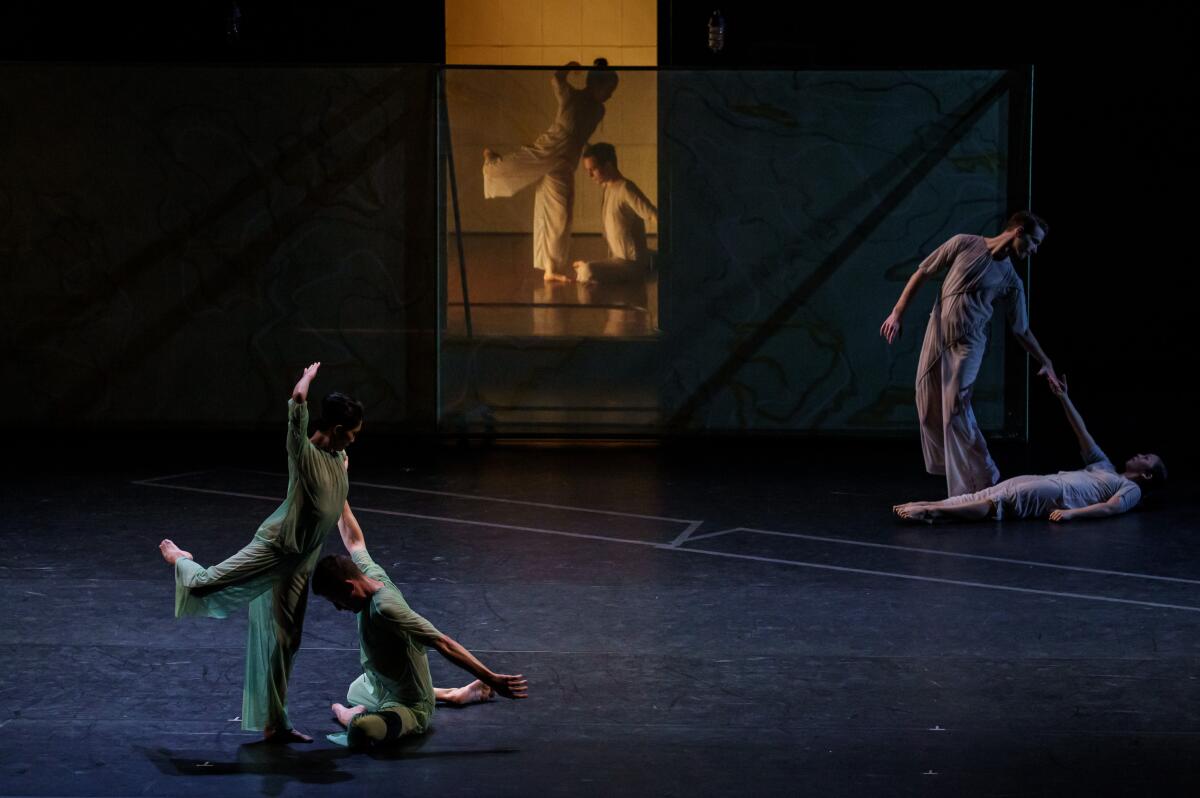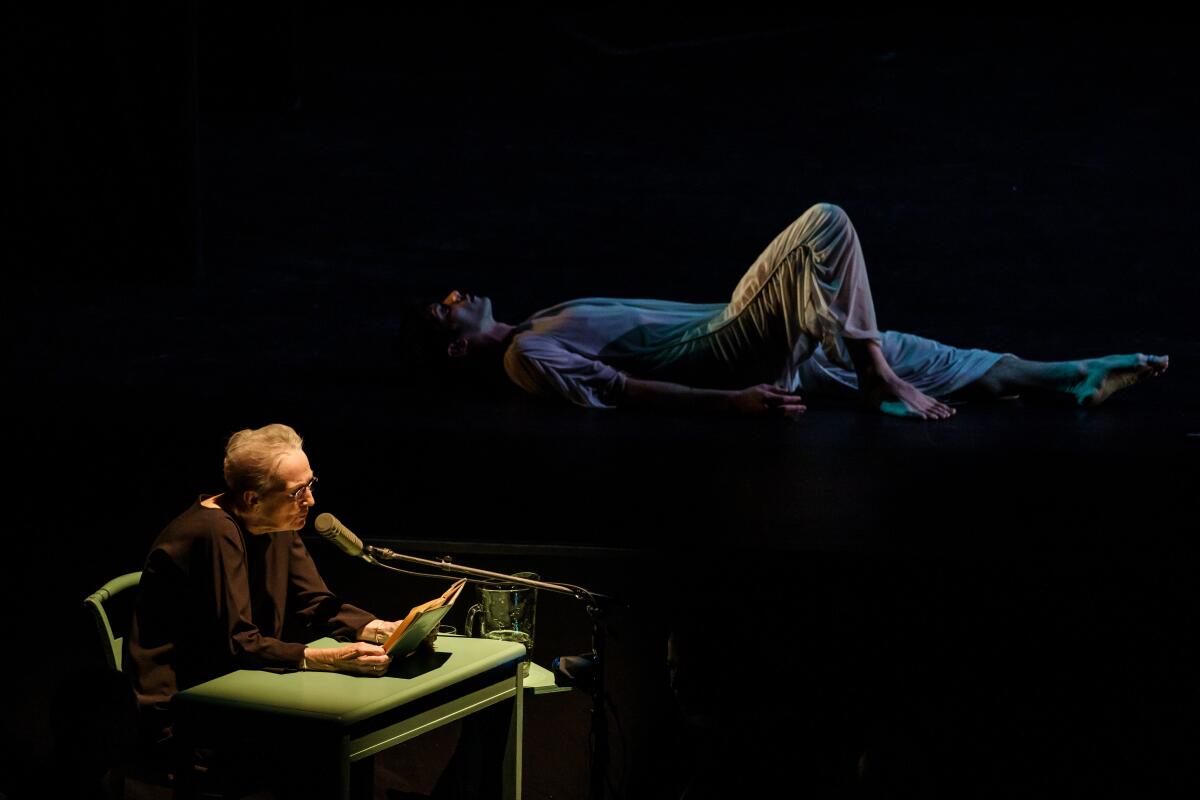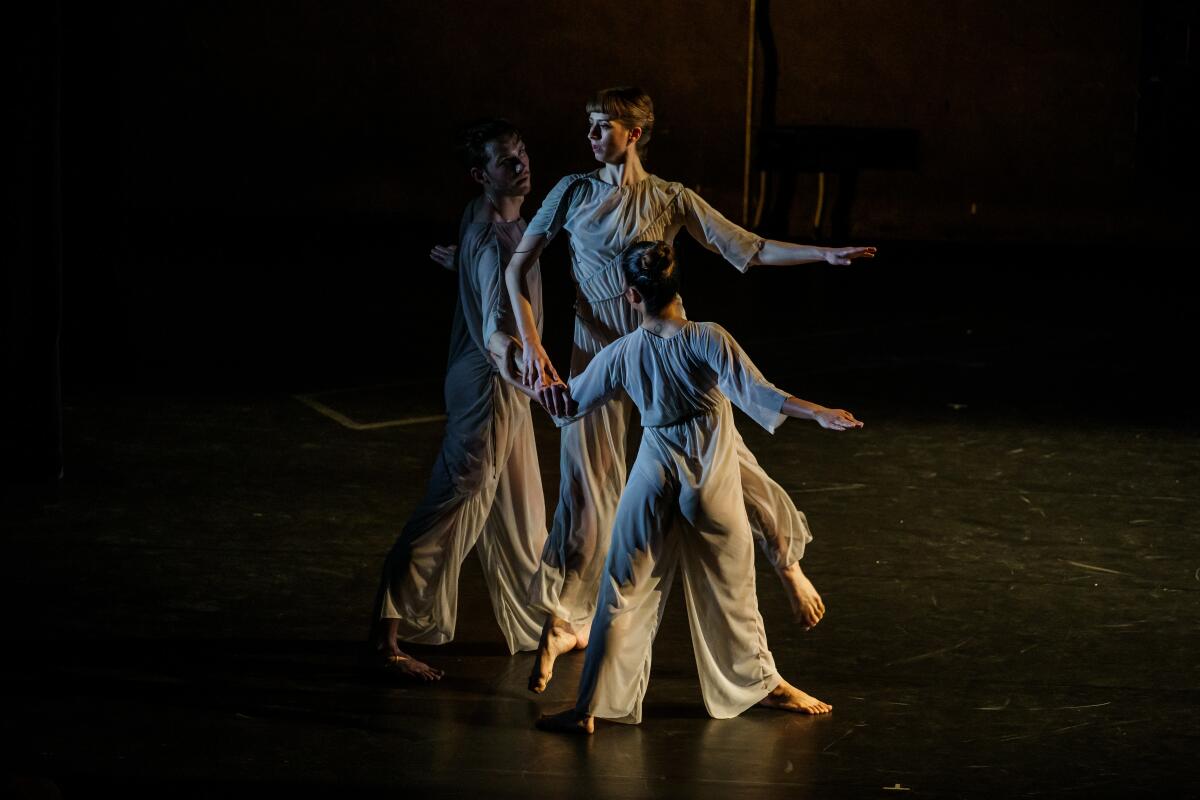A celebrated actress, choreographer, composer and painter stage T.S. Eliot’s ‘Four Quartets’

- Share via
In 2018, Pam Tanowitz choreographed T.S. Eliot’s “Four Quartets,” with an original score by Kaija Saariaho and a scenic design that incorporates paintings by Brice Marden. It was the 75th anniversary of the publication of Eliot’s four meditations on time and spiritual transience written at the start of World War II.
The premiere, which included actress Kathleen Chalfant (“Angels in America,” “Wit”) reading Eliot’s four poems, took place that summer at Bard College, and the response was of extravagant praise for every element of the collaboration, though most of all for Tanowitz’s dance. In his New York Times review, Alastair Macaulay found it “the greatest creation of dance theater this century.” Last May, the work traveled to London and to equally rapturous response.
It is that admirable. “Four Quartets” was revived for only a third time by CAP UCLA with two performances Saturday night and Sunday afternoon at Royce Hall. I saw the matinee.
The movement by Tanowitz, a choreographer’s choreographer long known to East Coast dance aficionados but barely on the radar of the larger dance public (the London “Four Quartets” was the first time her work has been seen outside the U.S), has a suppleness that is usually unexpected and never uninviting.
Everything sounds good. Saariaho’s incandescent score for string quartet and harp — superbly played by members of the Knights and given a resplendent amplified sound design by Jean-Baptiste Barriére — dazzles in its intensity. Chalfant reads Eliot’s sublime stanzas with a restrained elegance such that each reaches the listener as a marvel of imagery.
Speaking of imagery, everything looks just as good. Clifton Taylor turns Marden’s Minimalist paintings into a luminously lit scrim, backdrop and set of panels around which dancers perform.

No art form, here, competes with the other, and that even includes the diaphanous costumes by Reid Bartelme and Harriet Jung. The pale pastels blend effortlessly with Marden’s bold primary colors and transparency enhances dancers’ movements. The lighting, also by Taylor captures the soul of illumination.
Most important and most impressive of all, nothing competes with or makes an unenviable effort to find meaning in a text that stuffed with it. “Four Quartets” by Eliot goes deep. “Four Quartets” by Tanowitz, et. al., is thankfully and magnificently superficial.
There may be little about “Four Quartets” that is danceable, but its lines dance off the page when read with Chalfant’s unerring lilt. Eliot creates a seeable sense of place, each poem has both a specific and otherworldly setting. Stillness is evoked in a hundred ways. “There could be no dance, and this is only dance,” Eliot writes early on in the first poem, “Burnt Norton,” as he tries to go beyond poetry with poetry.
Miraculously, Eliot seems, 75 years later, to speak directly to us. “Distracted from distraction by distraction,” he writes, as though yesterday, “Filled with fancies and empty of meaning.” Or: “Not here the darkness, in this Twittering world” (the capital T, mine).
In this Beethoven year celebrating the composer’s 250th anniversary, when practically every composer is asked to have a dialogue with Beethoven, Eliot demonstrates how he could, with a brilliant intentionality, shape his “Four Quartets” as though they were late Beethoven quartets. Christopher Walken, of course, quotes Eliot in the 2012 film “A Late Quartet.”
Tanowitz has said in interviews that she visited the British locations Eliot describes to get a feel for them, but she steers clear of any illustration. The same goes for all the contributors. What that means is they steer clear of Eliot’s own intentions.

The poet seduces us into the very essence of being, taking in what was then fashionable Asian thought about how all we can know is of the present as it is lived. He wrote during a very real crisis of faith in humanity at time of unparalleled destruction. For him, redemption is, controversially, found necessarily in Anglican prayer. Appropriation of Hinduism, quantum physics and all else is disapprobation.
The dance begins with a long abstract solo, expressive but, opposite of Eliot’s manner, not insistent upon anything specific. A man enters. Relationships in duos, and later ensembles, remain indistinct and, because of that, of lasting interest. Throughout the 75-minute performance, Tanowitz’s outstanding company serves to add to Eliot not interpret. Complexity grows upon complexity.
After a dazzling harp introduction, Saariaho’s score doesn’t really get going until the second poem, “East Coker,” with long passages of spectral harmonics, vibrating and “twittering” (not to poetic birdsong or anything else). Marden’s paintings, made over the last nearly four decades, are marvelously what they are. No more and no less, but spiritual, for sure, while hinting toward Eastern religion.
In the third poem, “The Dry Salvages,” music and dance come closest to amplifying Eliot, climaxing as the poet begins to reach for revelation. In the last poem, “Little Gidding,” named for a 17th century Anglican community, Eliot, living in terror of Nazi bombing, finds Western civilization only savable from fire by fire, namely Christ.
There is no fire for this stage. Music and dance take on the character of dirge. Eliot stops with: “And the fire and the rose are one.” Musicians and dancers stop as they are, not one but many.
In the end, movement, light, music and text are all surfaces in this “Four Quartets” that prevent Eliot’s words from congealing. Those words are taken on their word, standing on their own, becoming their own kind of theater.
Eliot used modernity to reject modernity. But rejecting Eliot’s rejection of poetry and even further rejecting Eliot’s reasoning and orthodoxy, this exceptional response to “Four Quartets” achieves genuine universality and profound nowness.
More to Read
The biggest entertainment stories
Get our big stories about Hollywood, film, television, music, arts, culture and more right in your inbox as soon as they publish.
You may occasionally receive promotional content from the Los Angeles Times.











